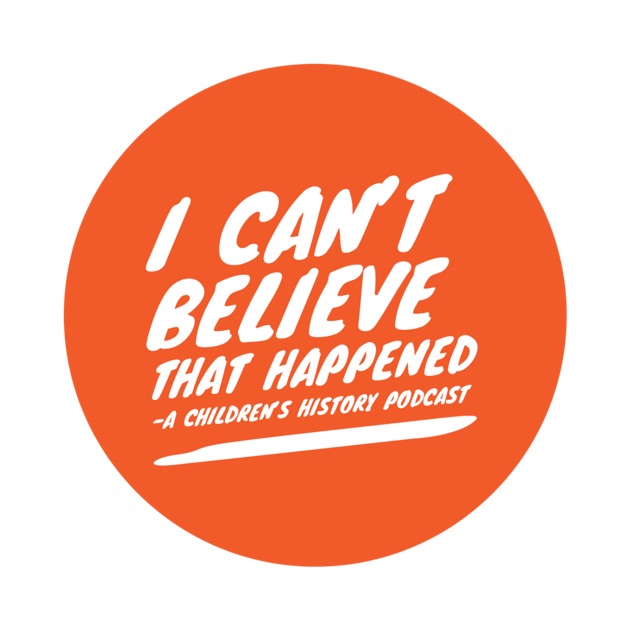
I Can't Believe That Happened History Podcast for Kids
Monica Michelle
I Can't Believe That Happened, a children's podcast every week full of interesting moments in History.
- 6 minutes 5 secondsRoosevelt's Zoo: Presidential Pets
🎙️ Hey there, history buffs! Did you know Teddy Roosevelt and his six kiddos were practically running a zoo in the White House? 🐻🐍 With over 40 pets, including a badger and even a bear 🦡, their adventures are bound to blow your mind! Tune in to our kids history podcast #WildWhiteHouse 🏰🐾 #PodcastFun
If you enjoyed please pass along to friends and your online community.
If you found the mistake I hid in the episode please head over to www.owlandtwine.com and email me the correct answer so I can share your name on our next episode.
Sources:
https://www.nps.gov/thrb/learn/historyculture/roosevelt-assorted.htm
https://www.cbsnews.com/news/presidential-pets-the-roosevelts-menagerie/
https://www.presidentialpetmuseum.com/theodore-roosevelts-bears/
https://www.presidentialpetmuseum.com/presidents/26tr/
https://kids.nationalgeographic.com/history/article/presidential-pets
https://www.cnn.com/interactive/2021/02/politics/white-house-pets/
Hosted on Acast. See acast.com/privacy for more information.
28 July 2023, 1:48 pm - 10 minutes 6 secondsMatthew Henson: First Man on the North Pole: Black History Month I Can't Believe That Happened
Mathew Henson
Explorer
I think I am going to do a series of PLEASE SOMEONE IN HOLLYWOOD MAKE A MOVIE ABOUT THIS PERSON
Tell me at the end if you would not sit and binge an entire series about Mathew Henson one of the first people to go to the NorthPole in our Black History month for I Can’t Believe That Happened.
Born August 8 1866 on a farm in Maryland
He was the middle child with an older and a younger sister
His parents were free sharecroppers who escaped to Georgetown after the KKK made southern Maryland too violent to stay.
Mathew was orphaned at a young age and raised by his uncle in Washington DC.
He earned money by washing dishes in a restaurant.
During the speeches of 1863 Mathew was deeply inspired by Fredrick Douglas.
At the age of 12 he became a cabin boy on the Katie Hines traveling to ports in China, Japan, Africa, and the Russian Arctic.
During his time on the Hines he was educated by the ship’s captain
When he returned to land he worked in a clothing store where he met Commander Robert E Peary. Once Robert learned of Mathew’s sea experience eh recruited him for a surveying tour of Nicaragua. Mathew impresses Peary on the voyage and became first man on all upcoming trips.
For twenty years the expeditions centered around the arctic where they traded heavily with the Inuit. Mathew learned their language and was said to be the only non Inuit who became skilled in driving the sled dogs and training the dogs in the Inuit way.
He was a skilled craftsman who learned to build igloos from snow and other mobile housing.
In 1909 Peary mounted an expedition to reach the North Pole. He and Mathew boarded the Roosevelt leaving Greenland along with four Inuit assistants, Four Inuit guides named Egingwah, Ooqueah, Ootah, and Seeglo, and were the first people to set foot on the North Pole.
Mathew was one of six chosen to make the final leg of the journey. Reports have it that Henson was no longer able to continue by foot and used the dog sled to scout ahead of the group.
Henson was the one to plant the American flag.
There was much controversy about the story but their accounts are backed up by the National Geographic association as well as the Naval Affairs Subcommitee of the U.S. House of Representatives.
In 1912 he wrote a book about his experiences traveling widely to give speeches about his experiences. Though Henson was a very important part of the expedition it was Peary who received most of the fame and focus. Henson spent years working as a clerk.
Long overdue in 1937 Henson was given membership to the New York Explorers Club.
Congress awarded him the Peary Polar Expedition Medal in 1944
He was honored by President Truman and President Eisenhower before he died in 1955
Bibliography
https://www.arlingtoncemetery.mil/explore/notable-graves/explorers/matthew-henson
Hosted on Acast. See acast.com/privacy for more information.
25 February 2023, 1:00 am - 7 minutes 45 secondsOne Ring To Rule Them All: The Ring That InspireD J.R.R. Tolkien's Lord of the Rings
Welcome to I Can’t Believe That Happened and our first episode on the History of Cursed Jewels.
A quick reminder I always throw in one wrong fact.
If you find it send me and email and let me know what the right fact is and what your source is.
Let’s start with the Ring of Dwarf Hill that inspired The Lord of the Rings author J.R.R. Tolkien
What if I told you that some of his epic fantasy came from actual history?
Let’s talk about:
The One ring to rule them all.
The ring that had all of middle earth in a massive power struggle.
Hosted on Acast. See acast.com/privacy for more information.
9 December 2022, 2:30 pm - 5 minutes 6 secondsThe Surprising History of Cursed Jewels, Jewelry, and Gemstones
What is it about minerals and gemstones that we find so amazing even beyond their beauty? We give them a supernatural power from healing crystals, to purifications, to remembering our dead with memento mori, to of course curses of long-dead powerful rulers wishing to keep their riches in to the eternity of the afterlife.
We have told stories about cursed gems. There have been books and movies. You will certainly have heard of a few of the stories before or you might find out your favorite tale comes from one of these histories.
When studying history we find often that the most frightening part of the tale is not the supernatural but in the way that people can set aside kindness and treat others in a way that they themselves would not wish to be treated in obtaining a symbol of power and beauty.
As you might imagine the history of jewels is full of these tales. While this is meant to be a fun romp through history I want to leave you with this, never forget those in the margins of your history books and whenever you can choose kindness.
Now lets go far back into a world where stones are so much more than a decoration.
............
Hosted on Acast. See acast.com/privacy for more information.
4 November 2022, 10:35 pm - 8 minutes 57 secondsMercy Otis Warren: Playwright, Historian, and Whistleblower July 4
Mercy Otis Warren: Revolutionary Playwright, Historian, and Whistleblower July 4 Episode
In researching the revolution so many names came up that even with my decades of love of history I had never heard. Mercy Otis is one. Which is surprising given how much she did during and after the revolution and the president’s who held her views in high regard. She not only wrote to presidents )who wrote back) but she published plays, pamphlets, and the first history of the revolution published by and American. Though the presidents admired (or mostly admired) her work she did have some critiques on them. She was anti slavery believing that such horrors were undermining to what the country was based on. She was angry at the treatments of the First Nations people and as you may expect was angered that there was no place for women in the new laws.
Hosted on Acast. See acast.com/privacy for more information.
3 July 2022, 2:46 am - 9 minutes 18 secondsThe Heroes of the Air: Versailles A Duck, A Rooster, and A Sheep
A duck, a Rooster, and a sheep wander into a wicker basket. This is not a joke it is the start of our podcast and the beginning of the ability for humans to fly. 19 September 1783 at 1 PM a cannon blasts and our Heroes of the air walk and waddle their way into history in the courtyard of Versailles in front of 130,000 people including the Queen, Marie Antoinette and King Louis.
Joseph and Étienne Montgolfier had spent the years earlier experimenting with hot air and in the beginning, laundry to develop their hot air balloon.
Take a listen and find out how we began flying.
Hosted on Acast. See acast.com/privacy for more information.
3 May 2022, 11:20 pm - 8 minutes 38 secondsBeatrix Potter Children's Book Author, Scientist, and Farmer A Ten Minute Children's History PodcastBeatrix Potter is beloved by so many of us for her darling illustrated children's books but did you know she was a scientist who changed the English landscape? It's time to learn all about this amazing woman, her love for animals, her brilliant scientific mind, and her love of nature.
Hosted on Acast. See acast.com/privacy for more information.
2 March 2022, 8:00 pm - 10 minutes 4 secondsElizabeth Jennings The Woman Who Started Desegregation of New York Transportation System:Black History Month
Our first black history month at 10-minute history podcast for kids!
This week we are going to be taking a look at Elizabeth Jennings Grahm the woman who started the desegregation of the New York transportation system in the 1800’s.
Hosted on Acast. See acast.com/privacy for more information.
12 February 2022, 4:00 am - 12 minutes 20 secondsChess Playing Turk Chess Automaton That Fooled The World
The Chess Playing Turk Automaton
The magic trick that astounded the world was not made by a magician. It was not even intended to be a magic trick. It was a challenge and from the challenge one of the most interesting stories about magic and robots came to be.
- Maria Theresa of Austria had a performance planned for her court in 1769 to watch a demonstration of magnetic tricks.
- Her counselor, a Hungarian scientist Wolfgang Von Kempelen was unimpressed and said he could do better He returned in 1770 to perform, the creation took him six months.
- Created a life-size automaton. The Turkish chess player. He showed the court all of the mechanics. All the court saw was the gears and rods that would make the automaton move.
- The automaton was wound up ready to play, and a member of the court was chosen to play chess against the automaton.
- The court reported to hearing whirrs and clicks as the automation moved its' pieces.
- The automaton nodded twice to signal the check and three times for checkmate off its' opponent.
- The chess-playing Turk Automaton gathered many famous challengers playing and defeating Benjamin Franklin and Napolean Bonaparte. Edgar Allan Poe wrote an essay about the automaton.
- Wolfgang was not a magician he was a naturalist, a scientist, an architect, and a hydraulic engineer.
- The automaton had a long “life” touring Europe and the Americas for 84 years.
- The device was later purchased in 1804 and exhibited by Johann Nepomuk Mälzel. Maazel installed a voice box in the automaton that would say check whenever it cornered its’ opponent's king.
- Maazel set up the game with Napolean. It was said that the emperor, who ultimately lost, attempted to cheat multiple times with the automaton shaking its’ head and placing the chess piece back where it had been.
- How did a machine play chess? How did it account for variables and strategy? You are going to have to think outside the box to solve this puzzle.
- If you did not guess don’t feel badly. This automaton confounded most of the world. The gears were a front. A hidden cabinet exited where a very small chess master could fit inside the secret compartment and play using puppeteering levers and dangling metal discs that were attracted to the magnets at the base of the chess pieces.
- The chess masters who secretly operated it included Johann Allgaier, Boncourt, Aaron Alexandre, William Lewis, Jacques Mouret, and William Schlumberger, but the operators within the mechanism during Kempelen's original tour remain a mystery.
- The illusion was completely shattered when Maelzel died unexpectedly in 1838 and the automaton was taken by one of his creditors.
- The original automaton was destroyed in a fire but there are reproductions. John Gaughan spent a reported 120,000 to build his own version in 1984. It uses the original chess board which had not been destroyed in the fire. It ran not with a human chess master but with a computer running a chess program.
Bibliography:
Magic 1400’s-1950’s
Daniel, Noel Caveney, Mike Jay, Ricky and Steinmeyer Jim
Taschen
Wikipedia
https://en.wikipedia.org/wiki/The_Turk
Hosted on Acast. See acast.com/privacy for more information.
13 January 2021, 2:30 pm - 11 minutes 35 secondsThe History of Robots- The Silver Swan-
Created by
Name: John Joseph Merlin (1735-18030)
Apprentice to James Cox.Musical inventor, created a museum called Merlin's Mechanical Museum in Princes Street
In the 1760’s created something like inline skates but forgot a braking system, he tested these two-wheel skates at a party while playing a violin where he became closely acquainted with a large and expensive mirror.
and James Cox ( 1723-1800)
An incredible businessman who reminds me of P.T Barnum. He ran the most expensive museum called the Cox museum. The goal of the museum was to attract royal patrons.
The Swan was created by Merlin and Cox in 1773
The swan was described in a 1773 Act of Parliament as being 3 feet (0.91 m) in diameter and 18 feet (5.49 m) high.
It is life-size
The swan is no longer this tall which brings the question if there was a second swan that might be lost or stolen like the waterfall that was behind the swan that was stolen while the swan was on tour.
The swan automata has a long and interesting history. It was exhibited at the Paris World’s Fair n 1867 and was bought and sold many times.
The swan was admired by Mark Twain during its’ display at the Paris International Exposition of 1864,
‘I watched the Silver Swan, which had a living grace about his movement and a living intelligence in his eyes - watched him swimming about as comfortably and unconcernedly as it he had been born in a morass instead of a jeweler’s shop - watched him seize a silver fish from under the water and hold up his head and go through the customary and elaborate motions of swallowing it...'
When the crank is turned the swan looks around itself then preens its’ silver feathers. It then swings its’ head around searching for the silver fish in the waves of glass. When she finds her prey she swoops down grabbing the wriggling fish in her mouth
Most recently restored 40 years ago, there are three separate clockwork motors. One is for the music, activating steel hammers that strikeout eight tinkling tunes. Another creates the illusion of the babbling brook and its darting fish. A series of camshafts, rollers, and levers rotate twisted glass rods on which seven fish are attached. During the restoration, it was discovered that instead of heading in the same direction, three of the fish were meant to swim forward, the rest backward. It is thought that three of the fish are from the 18th century and four from the 19th.
Bowes bought the swan in 1873 for $318 roughly $32,000 today.
Due to the current pandemic, it looks like the swan might need some more work. During normal times the museum had the swan’s feeding schedule set for 2 PM every day. Since the pandemic, the swan was shut down, once the museum reopened there seems to be a problem with starting the swan back up.
Hopefully, this stunning automata will be back in working order soon!
The swan can be visited at the Bowes Museum in County Durham
Bibliography
https://www.thebowesmuseum.org.uk/Collection/Explore-The-Collection/The-Silver-Swan#
https://www.cultofweird.com/curiosities/silver-swan-automaton/
https://www.wsj.com/articles/SB10001424127887324355904578159601753981708#:~:text=Bowes%20bought%20it%20in%201872,Clock%20in%20the%20Hermitage%2C%20St.
Hosted on Acast. See acast.com/privacy for more information.
28 December 2020, 11:16 pm - 13 minutes 18 secondsHistory of Robots: Jaques de Vaucanson :Pooping Robot Duck & the Flute Playing Automaton
Jaques de Vaucanson
Early Life:
Jaques de Vaucanson was born in Grenoble, France in 1709
10th child to a poor family of glove makers
Jaques wanted to become a clock maker as a child. His mother being very religious took Jaques to church with her. While she was in confession Jaques would watch the clock until he memorized its’ mechanisms to such perfection he was able to recreate it at home.
When Jaques father died when he was seven he was sent to live and train with the Jesuits. It was a difficult place for Jaques and he did poorly unable to concentrate on lessons. He was even punished for having cogs and wheels to create a boat in his possessions. There was a stand off with the priests where he refused to learn until a teacher would help him make a boat that could cross the pond. After being punished a math teacher and monk decided to help Jaques.
Later he became reacquainted with his love of mechanics after meeting the surgeon Claude-Nicolas Le Cat this is where his love of anatomy came from that will feature in his work.
At 18 he had his first automaton workshop in Lyon in 1727. Jaques created a robot that would serve the dinner and clear the table. Instead of being impressed one of the politicians found the robot to be an insult to the natural order and demanded the workshop to be destroyed.
This era was the time of the robots. They were all the rage in the royal courts though were often classified as toys or games.
Jaques was also greatly admired by the famous minds of his time. Voltaire even called him a "new Prometheus".
Robots:
The Flute Player
The flute player while a marvel was Jaques first steps into creating not just a robot that would perform tasks but a robot that could imitate life. In 1737 the flute player was made as a life size Shepard that could play 12 songs.
It is said that the flute player came to him in a fevered dream during a four month illness.
Vaucanson had been told by a musician that the most difficult instrument to play and tune was a flute. The challenge was set and he decided to make an automaton that would not just mimic playing but would actually play the most difficult instrument.
This is what made the flute player unique in a court full of interesting automata was that the machine was playing the music as if it were alive using fashioned lungs that created the breath, fingers that moved, and a mouth that created the shapes need to make the music. The robot was playing the flute in an approximation of how a human would. He also created a tambourine player and a pipe and drum player based on the same principles.
The Digesting Duck:
When attendance and money fell of from his musicians in 1739, Jaques turned to something entirely new, the digesting Duck.
“…it was the same size as a living duck. It could drink, muddle the water with its beak, quack, rise and settle back on its legs and, spectators were amazed to see, it swallowed food with a quick, realistic gulping action in its flexible neck.” Gaby Wood
It is important to say the duck would grab pellets from the hands of visitors, gulp the food down a tube where the pellets would be “digested” in the duck’s stomach and then the duck would poop out the food. The entire food cycle in a robot duck all to the hilarity and enraptured crowd of France.
Research:
This Eighteenth-Century Robot Actually Used Breathing to Play the Flute
By Kat Eschner
SMITHSONIANMAG.COM
FEBRUARY 24, 2017
Living Dolls: A Magical History Of The Quest For Mechanical Life by Gaby Wood The Gaurdia
Hosted on Acast. See acast.com/privacy for more information.
17 June 2020, 2:00 pm - More Episodes? Get the App
Your feedback is valuable to us. Should you encounter any bugs, glitches, lack of functionality or other problems, please email us on [email protected] or join Moon.FM Telegram Group where you can talk directly to the dev team who are happy to answer any queries.
 Pens & Pixels Popcast
Pens & Pixels Popcast
 A Teaspoon of Healing
A Teaspoon of Healing
 Young Black & Bothered
Young Black & Bothered
 King of Quotes
King of Quotes
 Section 247 Podcast
Section 247 Podcast
 Mr. Throwback Thursday
Mr. Throwback Thursday